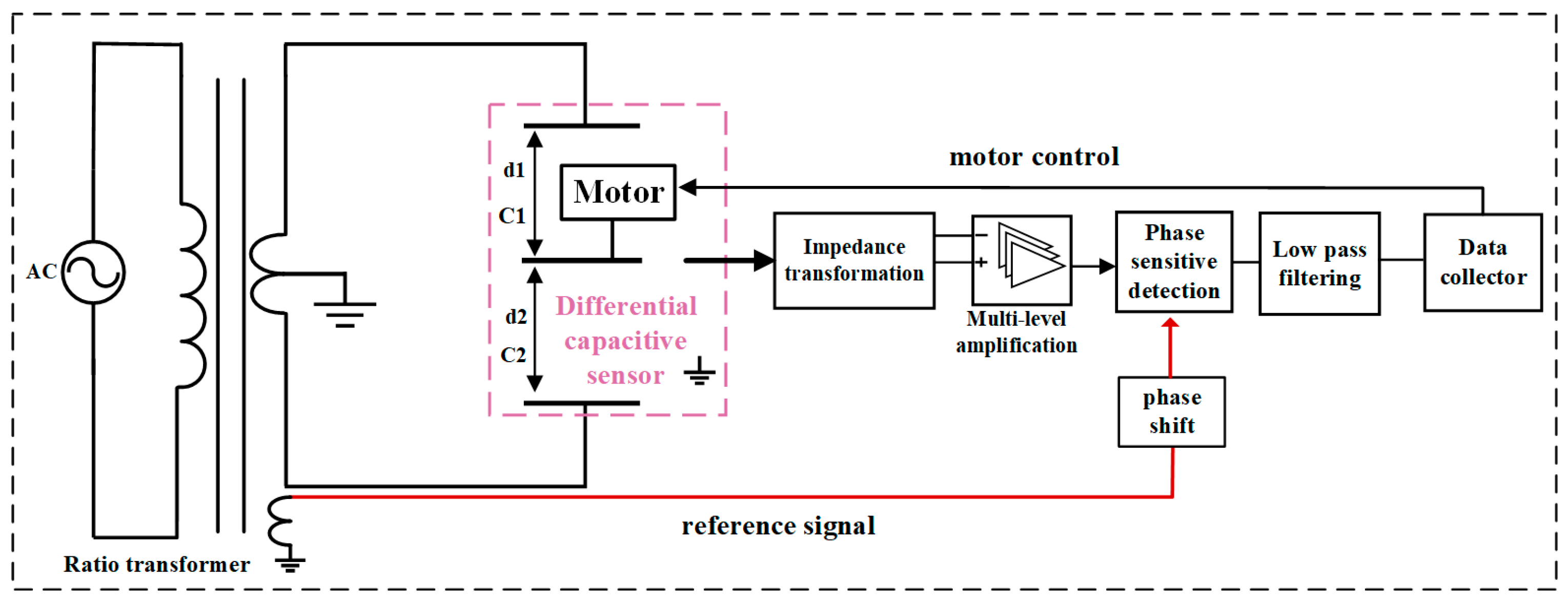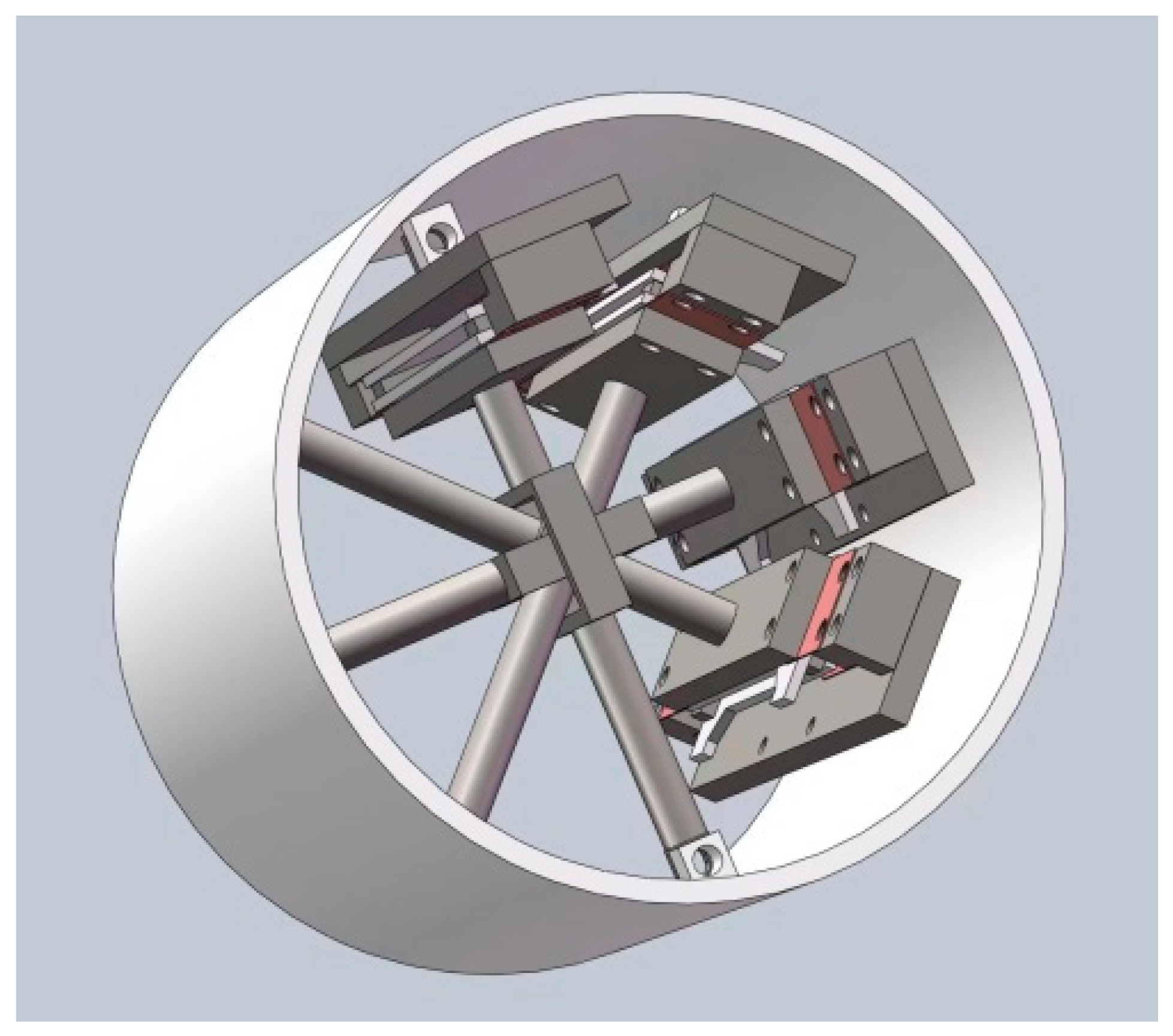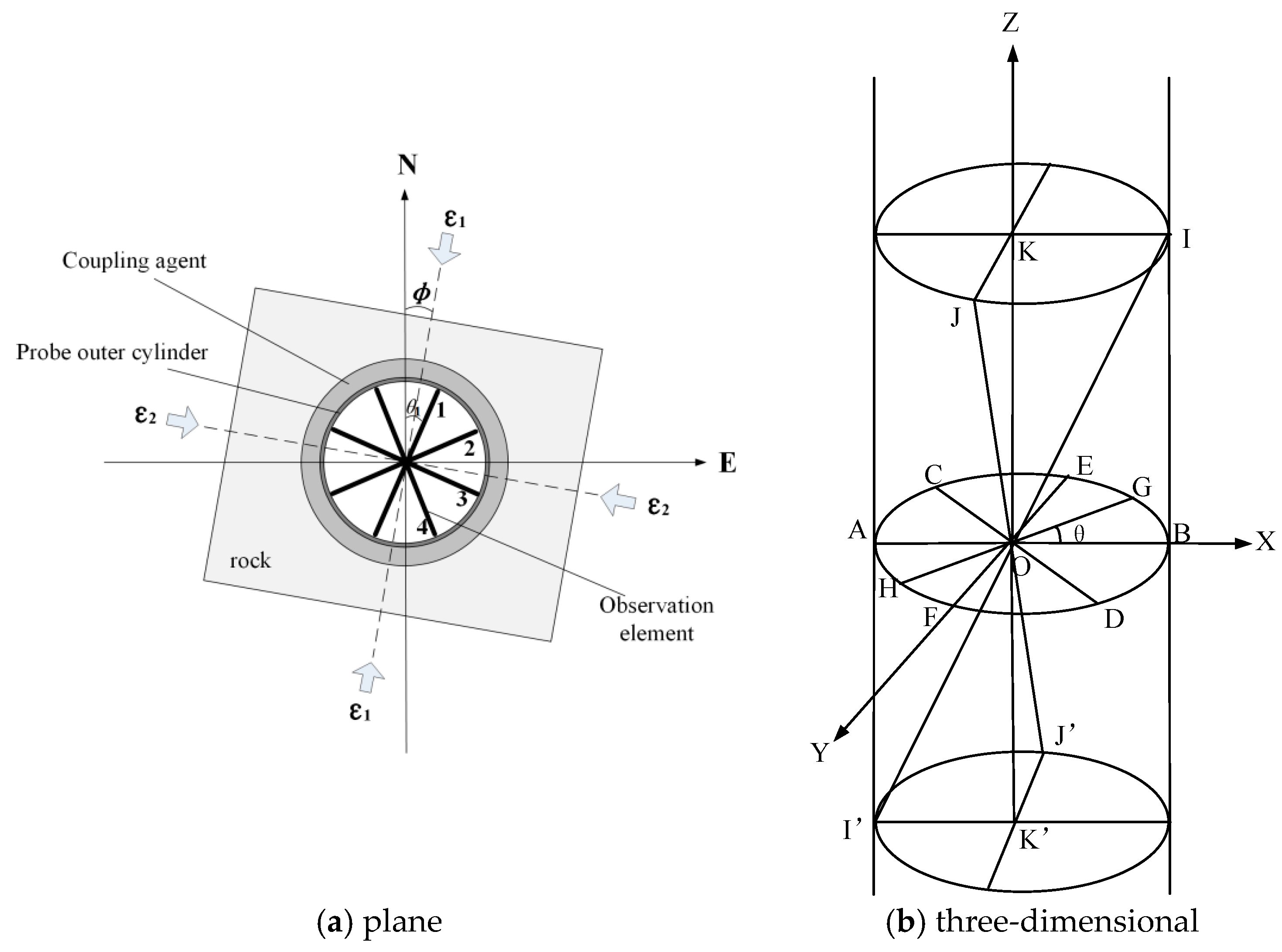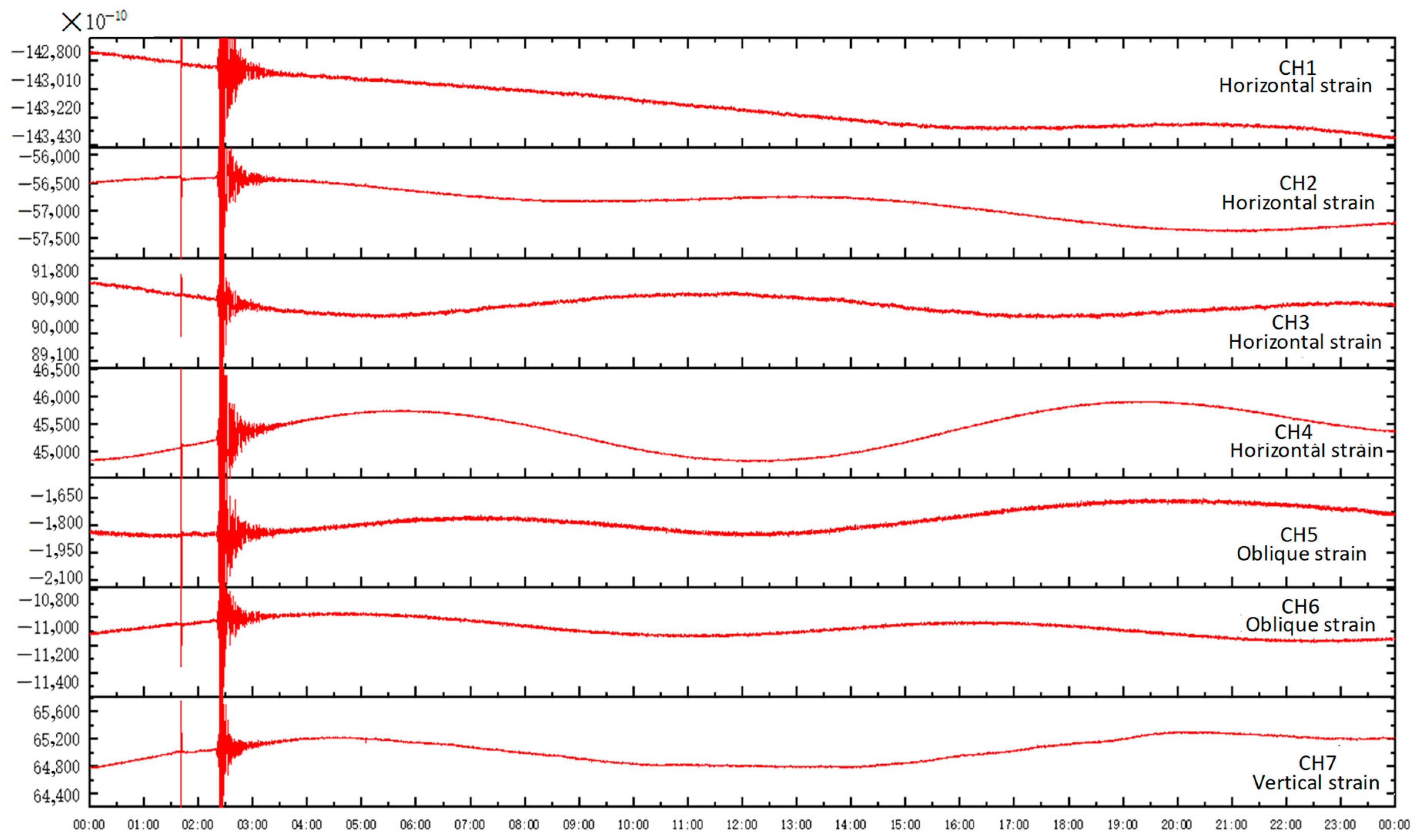Research on the RZB-Type Three-Dimensional Drilling Strain Measurement System
Abstract
:1. Introduction
2. Structure of RZB Three-Dimensional Strain Probe
2.1. Horizontal Strain Probe Structure
2.2. The Structure of a Vertical Strain Probe
2.3. Inclined Strain Probe Structural Units
2.4. Theoretical Model of Three-Dimensional Borehole Strain Observation
3. Differential Capacitance Microdisplacement Measurement Systems
3.1. Differential Capacitance Displacement Sensor and Ratiometric Bridge Measurement Circuitry
3.2. Differential Capacitive Micro-Displacement Sensor
4. RZB-Type Three-Dimensional Drilling Strain Gauge Field Installation Observation
5. Venedikov Reconciliation Analysis of Strain Data [36,37,38,39,40,41]
6. Conclusions
Author Contributions
Funding
Institutional Review Board Statement
Informed Consent Statement
Data Availability Statement
Acknowledgments
Conflicts of Interest
References
- Li, T.; Chen, Q.; Ouyang, Z.; Ning, J.; Wu, L. Application of the RZB borehole strainmeter in crustal stress observation at the eastern margin of the Tibet plateau. Acta Sci. Nat. Univ. Pekin. 2011, 47, 677–683. [Google Scholar]
- Chi, S. A shallow-hole mounted YRY-2 borehole strain gauge was observed at eight stations in North China. Acta Seismol. Sin. 1993, 15, 224–231. (In Chinese) [Google Scholar]
- Qiu, Z.; Xie, F.; Su, K.; Ouyang, Z. New Era of Borehole Strain Observation. Recent Dev. World Seismol. 2004, 1, 7–14. [Google Scholar]
- Xiong, Y.Z.; Li, H.; Wu, L.H.; Li, T.; Chen, Z.; Yu, J.J. Application of RZB Borehole Strainmeter in Crustal Stress Monitoring. In Proceedings of the International Congress on Computation Algorithms in Engineering (ICCAE), Bangkok, Thailand, 25–26 June 2016; Destech Publications, Inc.: Bangkok, Thailand, 2016; pp. 80–83. [Google Scholar]
- Su, K.; Li, H.; Zhang, J.; Li, X.; Ma, X. New Advances in Drill Site Strain Measurement; Seismological Press: Beijing, China, 2004. (In Chinese) [Google Scholar]
- Chen, D.; Su, K.; Geng, S. Seismic Topographic Observation Technology; Seismological Press: Beijing, China, 1995. (In Chinese) [Google Scholar]
- Evertson, D.W. Borehole Strainmeters for Seismology; Rep. ARL-TR-77-62; Applied Research Lab, University of Texas: Audtin, TX, USA, 1977; pp. 1–144. [Google Scholar]
- Tang, L.; Qiu, Z.; Li, Y.; Li, Y.; Fan, J. Determination and analysis of near-surface stress-strain state of 4-component borehole strainmeter. Geomat. Inf. Sci. Wuhan Univ. 2023. [Google Scholar] [CrossRef]
- Zoback, M.L.; Zoback, M.D.; Adams, J.; Assumpção, M.; Bell, S.; Bergman, E.A.; Blümling, P.; Brereton, N.R.; Denham, D.; Ding, J.; et al. Global patterns of tectonic stress. Nature 1989, 341, 291–298. [Google Scholar] [CrossRef]
- Zhu, R.; Xu, Y.; Zhu, G.; Zhang, H.; Xia, Q.; Zheng, T. North China Craton destruction. Chin. Sci. Earth Sci. 2012, 42, 1135–1159. [Google Scholar] [CrossRef]
- Du, F.; Wen, X.; Zhang, P. Interseismic deformation across the Longmenshan Fracture zone before the 2008 Wenchuan M8.0 earthquake. Chin. J. Geophys. 2009, 52, 2729–2738. [Google Scholar]
- Ran, Y.; Shi, X.; Wang, H. The maximum surface co seismic vertical displacement and surface deformation pattern of the Wenchuan MS8 earthquake. Chin. Sci. Bull. 2010, 55, 154–162. [Google Scholar] [CrossRef]
- Bai, Y.; Xu, X.; Xu, J.; Zhou, B. A research on the distribution of deformation fields near the fault of 2008 Wenchuan Earthquake. Chin. J. Geophys. 2011, 54, 1798–1804. (In Chinese) [Google Scholar]
- Zhang, P. Coseismic displacement field of the 2008 Wenchuan Ms8.0 earthquake measured by GPS. Sci. China Ser. D Earth Sci. 2008, 54, 1195–1206. (In Chinese) [Google Scholar]
- Xu, J.; Zeng, X. Tectonic Stress Redistribution Induced by Geothermal Gradient Difference: Numerical Modeling of Stress Around the Anninghe Seismic Gap in the Southeastern Tibetan Plateau. Pure Appl. Geophys. 2022, 179, 3713–3726. [Google Scholar] [CrossRef]
- Ishii, H. Development of new multi-component borehole instrument. Rep. Tono Res. Inst. Earthq. Sci. 2001, 6, 5–10. (In Japanese) [Google Scholar]
- Tang, L.; Fan, J.; Miao, M.; Chen, Z. Two Different Layouts of Sensors of Four-gauge Borehole Strainmeter and Their Influence on Field Measurement. Sens. Mater. 2022, 34, 4425–4434. [Google Scholar] [CrossRef]
- Chen, Z.; Li, T.; Ouyang, Z.; Wu, L.; Li, Y.; Ning, J. Three-dimensional measurement of a deep-seated RZB-type integrated wideband deformation observing system. Rock Stress and Earthquakes. In Proceedings of the Fifth International Symposium on In-Situ Rock Stress, Beijing, China, 25–27 August 2010; pp. 851–855. [Google Scholar]
- Chen, Z.; Ouyang, Z.; Li, H.; Li, T.; Wu, L.; Fan, G.; Zhang, J. The Vertical Strain Probe of RZB Deep-wideband Integrated Observing System. Technol. Earthq. Disaster Prev. 2014, 9, 126–132. [Google Scholar]
- Liu, X.-Y.; Wang, Z.-Y.; Ji, Y.-F. Analysis of 4-Component Borehole Strain Observation Based on Strain Invariant. Chin. J. Geophys. 2014, 57, 818–834. [Google Scholar]
- Zhang, L.; Niu, A. Discussion on solving the strain transfer coefficient of crustal rocks based on the double liner theory. Prog. Geophys. 2017, 32, 1525–1531. [Google Scholar]
- Qiu, Z. Theory and Application of Borehole Strain Observation; Seismological Press: Beijing, China, 2017. [Google Scholar]
- Institute of Geology and Mechanics, Chinese Academy of Geological Sciences. The Principle and Application of In-Situ Stress Measurement; Geological Publishing House: Beijing, China, 1981. [Google Scholar]
- Su, K. Ground Stress Measurement Methods; Seismological Press: Beijing, China, 1985. [Google Scholar]
- Ouyang, Z.; Li, B.; Jiang, W.; Zhang, Z. A Drilling Type In-Situ Stress Field Measurement System; Seismological Press: Beijing, China, 1988; Volume 2. (In Chinese) [Google Scholar]
- Ouyang, Z. Capacitance micrometer—Its features and applications. Electr. Meas. Instrum. 1975, 6, 9–29. (In Chinese) [Google Scholar]
- Ouyang, Z.; Zhang, J.; Chen, Z.; Li, T.; Wu, L.; Shi, J.; Zhang, Z.; Fan, G. New progress in multi-component observation of crustal deformation in deep boreholes. Recent Dev. World Seismol. 2009, 11, 1–13. [Google Scholar]
- Gladwin, M.T. High-precision multicomponent borehole deformation monitoring. Rev. Sci. Instrum. 1984, 55, 2011–2016. [Google Scholar] [CrossRef]
- Wu, L.; Chen, Z.; Li, T.; Ouyang, Z. Application of capacitive tilt sensor in crustal deformation measurement. Transducer Microsyst. Technol. 2010, 29, 129–131. [Google Scholar]
- Ruymbeke, M.V. Utilisation de capteurs capacitifs aux extensometres horizontaux. Marees Terrestres Bull. d’Inform. 1980, 84, 5350–5369. [Google Scholar]
- Wu, L.; Xiong, Y.; Li, T.; Chen, Z. In-Situ Linear Calibration Technique of the RZB-Type Borehole Strain Meter: Including a Laboratory Experiment. J. Geod. Geodyn. 2018, 38, 437–440. [Google Scholar]
- Walden, R.H. Analog-to-digital converter survey and analysis. IEEE J. Sel. Areas Commun. 1999, 17, 539–550. [Google Scholar] [CrossRef]
- Lindsey, W.C.; Chie, C.M. A survey of digital phase-locked loops. Proc. IEEE 1981, 69, 410–431. [Google Scholar] [CrossRef]
- Dorrington, A.A.; Kunnemeyer, R. A Simple Microcontroller Based Digital Lock-in Amplifier for the Detection of Low Level Optical Signals. In Proceedings of the 1st IEEE International Workshop on Electronic Design, Test and Applications, Christchurch, New Zealand, 29–31 January 2002; IEEE Computer Society: Christchurch, New Zealand, 2002; pp. 486–488. [Google Scholar]
- Yang, H.; Yang, S.; Liu, Y. Research on Weak Signal Detecting Circuit with Lock-in Amplifier. Piezoelectrics Acoustooptics 2015, 37, 529–532. [Google Scholar]
- GB/T 29.2—2008; Technical Requirements of Instruments in Network for Earthquake Monitoring-Geoelectrical Meters, Part 2: Meter for Geoelectrical Field. Seismological Press: Beijing, China, 2008; pp. 1–11. (In Chinese)
- Liu, X.; Li, P.; Zhang, Y. Calculation and Harmonic analysis of theoretical value of vertical strain Earth tide. Crustal Deform. Earthq. 1989, 04, 46–50. [Google Scholar]
- Liu, X.; Li, P. Harmonic analysis of the machine for calculating the theoretical value of strain Earth tide. Chin. J. Geophys. 1986, 29, 460–467. [Google Scholar]
- Schureman, P. Manual of Harmonic Analysis and Prediction of Tides; Special Publication No. 98. Revised (1940) Edition; U.S Department of Commerce Coast and Geodetic Survey: Reston, VA, USA, 1940. [Google Scholar]
- Ducarme, B. Computational procedures at the international center for Earth tides I.C.E.T. Marees Terrestres Bull. d’Inform. 1975, 72, 415–4181. [Google Scholar]
- Qiu, Z.; Shi, Y.; Ouyang, Z. Relative in-situ calibration of 4-component borehole strain observation. J. Geod. Geodyn. 2005, 25, 118–122. [Google Scholar]
- Tang, L.; Fan, J.; Liu, G.; Qiu, Z. The Reliability Analysis of Strain Seismic Waves Recorded by High Sampling Four-component Borehole Strainmeter. Earthq. Res. China 2023, 39, 78–87. [Google Scholar]
- Tang, L.; Qiu, Z.; Fan, J.; Yin, Z. The apparent focal depth, emergence angle, and take-off angle of seismic wave measured by YRY-4-type borehole strainmeter as one kind of strain seismograph. Front. Earth Sci. 2023, 11, 1036797. [Google Scholar] [CrossRef]
- Tang, L.; Qiu, Z.; Fan, J.; Luo, Z. Characteristic Analysis of Coseismic Variation of 4-Component Borehole Strain Observation with Different Sampling Rates. J. Geod. Geodyn. 2022, 42, 1196–1201. [Google Scholar]










| Strain Channel | Tidal Factor | Tidal Factor Mean Squared Error | Tidal Phase Lag | Tidal Phase Lag Mean Squared Error |
|---|---|---|---|---|
| CH1 (Horizontal strain) | 0.7005 | 0.0443 | −9.5667 | 3.6243 |
| CH2 (Horizontal strain) | 0.8918 | 0.0346 | −11.8036 | 8.5587 |
| CH3 (Horizontal strain) | 0.9821 | 0.0393 | 15.1021 | 9.5867 |
| CH4 (Horizontal strain) | 1.0082 | 0.0272 | −2.4895 | 0.9458 |
| CH5 (Oblique strain) | 0.9165 | 0.0209 | 9.1653 | 5.6526 |
| CH6 (Oblique strain) | 0.8469 | 0.0449 | −3.8329 | 3.6051 |
| CH7 (Vertical strain) | 1.1965 | 0.0388 | 8.1653 | 6.3626 |
Disclaimer/Publisher’s Note: The statements, opinions and data contained in all publications are solely those of the individual author(s) and contributor(s) and not of MDPI and/or the editor(s). MDPI and/or the editor(s) disclaim responsibility for any injury to people or property resulting from any ideas, methods, instructions or products referred to in the content. |
© 2024 by the authors. Licensee MDPI, Basel, Switzerland. This article is an open access article distributed under the terms and conditions of the Creative Commons Attribution (CC BY) license (https://creativecommons.org/licenses/by/4.0/).
Share and Cite
Chen, Z.; Li, H.; Dong, Y.; Wang, W.; Wu, L.; Zhan, W. Research on the RZB-Type Three-Dimensional Drilling Strain Measurement System. Sensors 2024, 24, 3954. https://doi.org/10.3390/s24123954
Chen Z, Li H, Dong Y, Wang W, Wu L, Zhan W. Research on the RZB-Type Three-Dimensional Drilling Strain Measurement System. Sensors. 2024; 24(12):3954. https://doi.org/10.3390/s24123954
Chicago/Turabian StyleChen, Zheng, Hong Li, Yunkai Dong, Wenbo Wang, Liheng Wu, and Weiwei Zhan. 2024. "Research on the RZB-Type Three-Dimensional Drilling Strain Measurement System" Sensors 24, no. 12: 3954. https://doi.org/10.3390/s24123954




